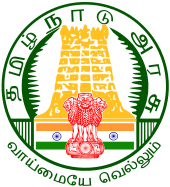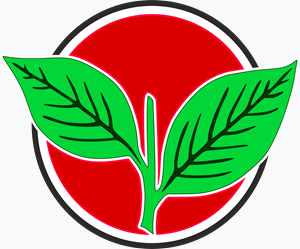
The All India Anna Dravida Munnetra Kazhagam is an Indian regional political party with great influence in the state of Tamil Nadu and the union territory of Puducherry. It is a Dravidian party founded by the former chief minister of Tamil Nadu M. G. Ramachandran (M.G.R.) at Madurai on 17 October 1972 as a breakaway faction from the Dravida Munnetra Kazhagam after M. Karunanidhi expelled him from the party for demanding an account as the party treasurer. The party is adhering to the policy of socialism and secularism based on the principles of C. N. Annadurai (Anna) collectively coined as Annaism by M.G.R. The party has won a seven-time majority in the Tamil Nadu Legislative Assembly and has emerged as the most successful political outfit in the state's history. It is currently the main opposition party in the Tamil Nadu Legislative Assembly.

The Dravida Munnetra Kazhagam is an Indian political party based in the state of Tamil Nadu, where it is currently the ruling party, and the union territory of Puducherry, where it is currently the main opposition.
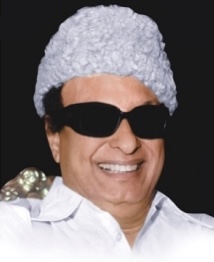
Maruthur Gopalan Ramachandran , popularly known by his initials M.G.R., was an Indian actor, politician, and philanthropist who served as the Chief Minister of Tamil Nadu from 1977 until his death in 1987. He was the founder and first general secretary of the All India Anna Dravida Munnetra Kazhagam. On 19 March 1988, Ramachandran was posthumously awarded the Bharat Ratna, India's highest civilian honour. Ramachandran is regarded as one of the most influential politicians of post-independence India. Apart from Politics, as an Film Personality he has won One National Film Award, two Tamil Nadu State Film Awards and two Filmfare Award South in his Career.

Muthuvel Karunanidhi was an Indian writer and politician who served as Chief Minister of Tamil Nadu for almost two decades over five terms between 1969 and 2011. He is popularly referred to as Kalaignar (Artist) and Mutthamizh Arignar for his contributions to Tamil literature. He had the longest intermittent tenure as Chief Minister of Tamil Nadu with 6,863 days in office. He was also a long-standing leader of the Dravidian movement and ten-time president of the Dravida Munnetra Kazhagam political party. Karunanidhi has the record of never losing an election to the Tamil Nadu Assembly, having won 13 times since his first victory in 1957. Before entering politics, he worked in the Tamil film industry as a screenwriter. He also made contributions to Tamil literature, having written stories, plays, novels, and a multiple-volume memoir. Karunanidhi died on 7 August 2018 at Kauvery Hospital in Chennai after a series of prolonged, age-related illnesses.
Politics of Tamil Nadu is the politics related to the Indian state of Tamil Nadu.
Dravidian parties include an array of regional political parties in the state of Tamil Nadu, India, which trace their origins and ideologies either directly or indirectly to the Justice Party and the Dravidian movement of C. Natesanar and Periyar E. V. Ramasamy. The Dravidian movement was based on the linguistic divide in India, where most of the Northern Indian, Eastern Indian and Western Indian languages are classified as Indo-Aryan, whereas the South Indian languages are classified as Dravidian. Dravidian politics has developed by associating itself to the Dravidian community. The original goal of Dravidian politics was to achieve social equality, but it later championed the cause of ending the domination of North India over the politics and economy of the South Indian province known as Madras Presidency.

The tenth legislative assembly election of Tamil Nadu was held on 24 June 1991. The All India Anna Dravida Munnetra Kazhagam (AIADMK) – Indian National Congress (INC) alliance won the elections in a landslide and AIADMK general secretary J. Jayalalithaa became the chief minister. This was her first term in office. The united strength of AIADMK, the alliance with the Congress, and the wave of public sympathy in the wake of Rajiv Gandhi assassination combined to produce a massive victory for the AIADMK. The DMK could only win 2 seats. This was the worst performance of the DMK since it entered electoral politics in the 1957.

The ninth legislative assembly election of Tamil Nadu was held on 21 January 1989. Dravida Munnetra Kazhagam (DMK) won the election and its leader M. Karunanidhi, became the Chief Minister. It was his third term in office. The DMK was in power only for a short term, as it was dismissed on 31 January 1991 by the Indian Prime minister Chandra Shekhar using Article 356 (Otherwise) of the Indian Constitution.

The eighth legislative assembly election for Tamil Nadu was held on 24 December 1984. All India Anna Dravida Munnetra Kazhagam (AIADMK) won the election and its general secretary, incumbent M. G. Ramachandran (M.G.R) was sworn in as Chief Minister, for the third time. The election victory was mainly attributed to the sympathy wave created by Indira Gandhi's assassination and M.G.R's illness coupled with Rajiv Gandhi's popularity. This is the last election M.G.R contested as he died in office in 1987. This is also the only General Election which M. Karunanidhi did not contest since 1957 until his death. As of 2023, this is the last election where the ruling party gained seats.

The sixth legislative assembly election of Tamil Nadu was held on 10 June 1977. All India Anna Dravida Munnetra Kazhagam (AIADMK) won the election defeating its rival Dravida Munnetra Kazhagam (DMK). M. G. Ramachandran, the AIADMK founder and a leading Tamil film actor, was sworn in as Chief Minister for the first time. The election was a four-cornered contest between the AIADMK, DMK, the Indian National Congress (INC) and the Janata Party. Earlier in 1972, M.G.R had founded the AIADMK following his expulsion from the DMK after differences arose between him and DMK leader M. Karunanidhi. On 31 January 1976, Karunanidhi's government was dismissed by the central government of Prime Minister Indira Gandhi citing non-co-operation for MISA and President's rule was imposed on the state. Karunanidhi had been at odds with Indira Gandhi over his opposition to Emergency and allied with Janata Party founded by Jayaprakash Narayan. M.G.R remained as Chief Minister until he died in 1987, winning the next two elections held in 1980 and 1984. Due to this feat, M.G.R inadvertently became an example for entry of famous actors to enter politics, with a hope that they too may become Chief minister one day. then Telugu superstar N.T.R followed M.G.R's suit in 1983 and won the Andhra Pradesh general Elections to become the Chief Minister of Andhra Pradesh. Since then, no other actor has been able to recreate M.G.R's achievements in electoral Politics.

The fourth legislative assembly election of Madras State was held in February 1967. The Dravida Munnetra Kazhagam (DMK) led coalition under the leadership of C.N. Annadurai won the election defeating the Indian National Congress (Congress). Anti-Hindi agitations, the rising prices of essential commodities, and a shortage of rice were the dominant issues. K. Kamaraj's resignation as the Chief Minister in 1963, to concentrate on party affairs, along with persistent rumors of corruption had weakened the incumbent Congress Government. This was the second time after Communist Party of India winning Kerala assembly elections in 1957, for a non-Congress party to gain the majority in a state in India, and the last time that Congress held power in Tamil Nadu. It was the first time a party or pre-election alliance formed a non-Congress government with an absolute majority. It marked the beginning of Dravidian dominance in the politics of Tamil Nadu. Annadurai, who became the first non-Congress chief minister of post-independence Tamil Nadu, died in office in 1969 and V.R. Nedunchezhiyan took over as acting chief minister.

The first legislative assembly Election to the Madras state based on universal adult suffrage was held in 27 March 1952. This was the first election held in Madras state after the Indian Independence. This election was officially known as the 1951 Madras State Election, even though through delays, actual voting didn't take place until early 1952.
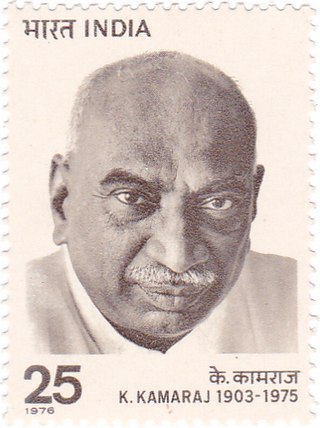
The second legislative assembly election to the Madras state was held on 31 March 1957. This was the first election held after the linguistic reorganisation of Madras State in 1956. Indian National Congress and its leader, K. Kamaraj won the election and defeated their rival, Dravida Munnetra Kazhagam. In 1954, due to the resignation of C. Rajagopalachari, for his controversial Kula Kalvi Thittam, the leadership of Congress was contested between K. Kamaraj, and C. Subramaniam. Eventually, K. Kamaraj, won the support of the party, was elected leader and chief minister of Madras State in 1954. In a surprise move, he appointed both M. Bhaktavatsalam and C. Subramaniam, to his cabinet, allowing great unity amongst the Congress that ruled the state of Madras, for the next decade. This election saw future DMK leaders M. Karunanidhi and K. Anbazhagan win their first MLA seats in the legislative assembly.

The Tamil Nadu Legislative Assembly is the unicameral legislature of the Indian state of Tamil Nadu. It has a strength of 234 members, all of whom are democratically elected using the first-past-the-post system. The presiding officer of the Assembly is the Speaker. The term of the Assembly is five years, unless dissolved earlier.
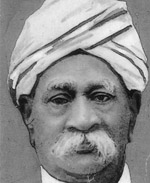
The first legislative council election to Madras Presidency after the establishment of dyarchical system of government by the Government of India Act 1919, was held in November 1920. Indian National Congress boycotted the election due to its participation in the Non-cooperation movement. The election occurred during the early stages of non-Brahmin movement and the major issue of the election was anti-Brahminism. Justice party won the election with no significant opposition and A. Subbarayalu Reddiar became the inaugural First Minister of the presidency.
Diarchy was established in Madras Presidency based on the recommendations of the Montague-Chelmsford report. Five elections were held during the period diarchy was in effect and Justice Party occupied power most of the time. It ended with the election in 1937 when the Government of India Act 1935 came into effect.
The fourth legislative assembly of Madras state was constituted in March 1967 after the assembly election which was held in February 1967. The assembly was the first non-Indian National Congress government of the state and, under chief-minister C.N. Annadurai, passed several key acts including the renaming of the state to Tamil Nadu and the abolition of the three-language formula in the state which had previously required Hindi to be taught in schools.
The list of political families of Tamil Nadu state in India.
